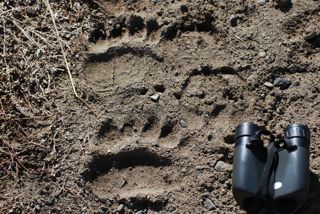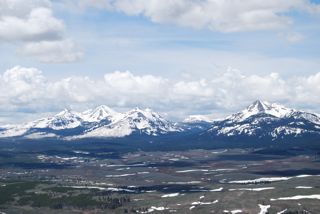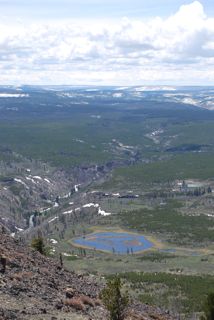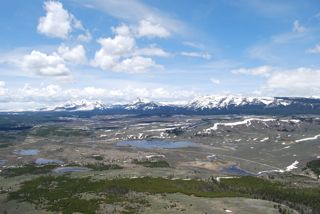The weather gifted me with a warm fall day of sun and temperatures in the sixties, which almost banished the painful memory of being buried in three feet of snow last weekend. Wanting to take advantage of the beautiful day, I hiked from my home up the Old Gardiner Road, one of the first roads built in Yellowstone. I could envision the yellow Tally-Ho coaches, pulled by six horses, rambling up the road and filled with eager (and dusty) tourists visiting the park.
 "This is an extremely large foot"The wet weather had created mud last week, and I observed a parade of assorted animal tracks on the dirt road as I walked. Bison and elk prints were in abundance.
"This is an extremely large foot"The wet weather had created mud last week, and I observed a parade of assorted animal tracks on the dirt road as I walked. Bison and elk prints were in abundance.
About halfway up the five-mile hike, I noticed a set of distinctive prints—grizzly tracks. A line from Mary Oliver’s delightful poem, Bear, suddenly resounded in my head: “This is not my track, and this is an extremely large foot.” I suddenly began contemplating the possibilities of being in the middle of the food chain.
Luckily or unluckily—I couldn’t decide—I encountered no bears. Once I arrived in Mammoth, I decided to extend my hike and explore the Mammoth Terraces. Yellowstone has settled into a quietness with the approach of winter as most of the facilities are closed until December, and as a result the visitors were scarce on the terrace boardwalks.
 Dead Tree on Main TerraceAlthough Mammoth Hot Springs is located outside the caldera boundary and lacks the showy geysers that populate the southern region of the park, it still boasts some pretty neat thermal features. The terraces, or travertine formations, decorate the hillside above Mammoth, creating nature’s version of a Greek temple.
Dead Tree on Main TerraceAlthough Mammoth Hot Springs is located outside the caldera boundary and lacks the showy geysers that populate the southern region of the park, it still boasts some pretty neat thermal features. The terraces, or travertine formations, decorate the hillside above Mammoth, creating nature’s version of a Greek temple.
Travertines are formed by geothermal water rising to the surface and depositing calcium carbonate, the main ingredient in limestone. Thermophiles, microbes who thrive in heat, paint the travertines with rich colors from pigments used in photosynthesis.
 Liberty CapSince the underground hot springs that form the terraces may shift direction or stop flowing, the resulting travertines can change rapidly. For example, last winter the water flowing out of Orange Spring Mound suddenly changed direction and began feeding into Upper Terrace Drive. And Liberty Cap, the 37 foot, 2,500 year-old formation that greets visitors at the start of the Lower Terrace Trail, flowed for hundreds of years before becoming dormant.
Liberty CapSince the underground hot springs that form the terraces may shift direction or stop flowing, the resulting travertines can change rapidly. For example, last winter the water flowing out of Orange Spring Mound suddenly changed direction and began feeding into Upper Terrace Drive. And Liberty Cap, the 37 foot, 2,500 year-old formation that greets visitors at the start of the Lower Terrace Trail, flowed for hundreds of years before becoming dormant.
F.V. Hayden named Liberty Cap in 1871, citing its resemblance to the peaked caps worn during the French Revolution that represented freedom. G.L. Henderson wrote a poetic description of Liberty Cap in 1888: "It looks like a silent sentinel guarding the gate of Wonderland; or like an ancient witness who could, if it would, reveal the sealed secrets of the past. It has more faces than Janus and more eyes than the fabled Argus."
You can visit my photo gallery for more pictures of Mammoth Hot Springs.





